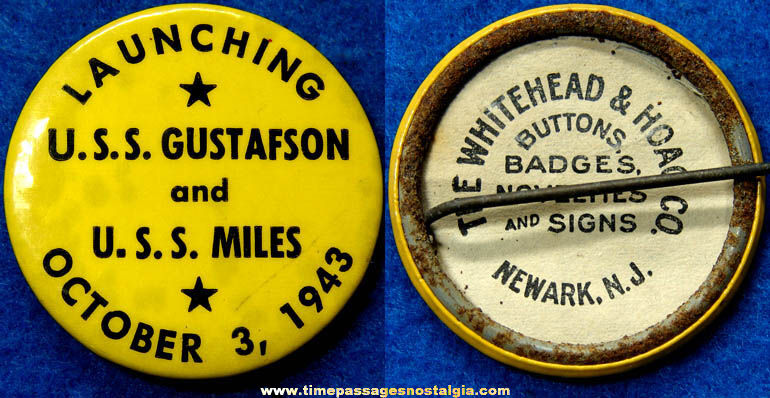
   | | | Any group of items being offered as a lot must be sold as a lot. | | All Original Items.
No Reproductions | Nostalgic Memorabilia, Pop Culture Artifacts, Historic Items,
and "Shoe Box Toys" | | We have an extensive inventory that is not yet on our web site. If there is something you are looking for and did not find, please send us your wish list. | It's never too late to
have a happy childhood! | | Fast Dependable Service | You don't have to be an eight year old to enjoy having
a childhood treasure. | Whether you've collected Memorabilia for years or just want to feel like a kid again, please take a few moments to browse through what we
have available for sale. | You can feel secure
shopping with PayPal. |
| | | | The picture shows a front and back view of this 1943 U.S.S. Gustafson & U.S.S. Miles Ship Launching Pin Back Button. This launching badge is believed to have been saved by a shipyard worker. It was found in a Staten Island, New York attic with many others dating from 1941 to 1944 when many ships were launched to do battle in World War II. They had been hidden away in that attic from the 1940s until 2008. The ships were launched from The Federal Shipbuilding & Dry Dock of Kearny, New Jersey. This pinback button is imprinted in black on a yellow background. There is a paper insert in the back. It is marked on the two sides as follows: U.S.S. GUSTAFSON
AND
U.S.S. MILES
LAUNCHING
OCTOBER 3, 1943 THE WHITEHEAD & HOAG CO.
NEWARK, N.J.
BUTTONS, BADGES, NOVELTIES AND SIGNS The pin back button measures 1-1/2'' wide. It is in good condition with some spotting and surface rusting on the back as pictured. Below here, for reference, is some information on the U.S.S. Gustafson and U.S.S. Miles: U.S.S. Gustafson (DE-182)
From Wikipedia, the free encyclopedia Career Laid down: 5 July 1943
Launched: 3 October 1943
Commissioned: 1 November 1943
Decommissioned: 26 June 1946
Struck: 20 December 1950
Fate: To Netherlands, 23 October 1950 General characteristics Class: Cannon class destroyer escort
Type: DET (diesel electric tandem motor drive, long hull)
Displacement: 1,240 tons (std) 1,620 tons (full)
Length: 306 ft. (93 m) overall
300 ft. (91 m) waterline
Beam: 36 ft. 10 in. (11.2 m)
Draft: 11 ft. 8 in. (3.6 m) maximum
Range: 10,800 nm at 12 knots (22 km/h)
Speed: 21 knots (39 km/h)
Complement: 15 officers, 201 enlisted
Armament: 3 - 3''/50 Mk 22, 1 twin 40 mm Mk 1 AA, 8 - 20 mm Mk 4 AA, 3 - 21'' Mk 15 TT, 1 Hedgehog Projector Mk 10 (144 rounds), 8 Mk 6 depth charge projectors, 2 Mk 9 depth charge tracks.
Propulsion: 4 GM Mod. 16-278A diesel engines with electric drive, 6000 shp, 2 screws. U.S.S. Gustafson (DE-182) was a Cannon class destroyer escort built for the U.S. Navy during World War II. She served in the Atlantic Ocean and provided escort service against submarine and air attack for Navy vessels and convoys. She was launched 3 October 1943 by the Federal Shipbuilding & Drydock Co., Kearny, New Jersey; sponsored by Mrs. Eva Smythe Stevens, widow of Lt. Gustafson ; and commissioned 1 November 1943, Comdr. Herman Rich in command. World War II Atlantic Ocean operations
Following shakedown training, Gustafson escorted coastal convoys in waters ranging from New York to Galveston, Texas. On 20 February 1944 she departed New York in the screen of two escort carriers for duty with Admiral Jonas H. Ingrain's U.S. 4th Fleet based at Recife, Brazil. This fleet kept down the German U-boat and raider menace in waters running south from Trinidad to the tip of South America, and across to the coast of Africa. On 14 April 1943, the destroyer escort put to sea in company with the escort carrier U.S.S. Solomons (CVE-67) to sweep the Atlantic Narrows. On the 23d, Gustafson made an unsuccessful hedgehog attack on a target that was probably German submarine U-196. Due south of St. Helena Island, 15 June 1943, aircraft launched by Solomons sank the German submarine U-860. Gustafson continued antisubmarine patrol and convoy escort in the South Atlantic. Operating out of Recife and Bahia, Brazil, she helped cover coastal waters from the border of French Guiana down to Rio de Janeiro and across the Atlantic narrows more than halfway to the coast of Africa. Ship Collision
On 22 November 1944, while escorting the Navy transport U.S.S. General M. C. Meigs (AP-16) to a mid-way rendezvous in the Atlantic Narrows, she closed alongside the cruiser U.S.S. Omaha (CL-4) to pass orders and the two ships collided. Both ships suffered damage but were able to complete the mid-ocean rendezvous escort mission. After temporary repairs at Bahia, Brazil, Gustafson proceeded north to the New York Navy Yard, arriving 21 December 1944. During a swift overhaul she received additional armament and a new Combat Information Center. Sinking of U-Boat U-857
Gustafson departed New York 22 January 1945 for antisubmarine warfare refresher training out of Key West, Florida. From there she proceeded in the escort of a slow convoy to Trinidad and ports of South America. She returned north in March and was stationed at Casco Bay as German Submarine U-857 moved into the Gulf of Maine. The U-boat announced its presence 5 April 1945 by torpedoing the American tanker S.S. Atlantic States. Two U.S. Coast Guard frigates and two destroyer escorts, including Gustafson, were soon hunting for the enemy. U-857 lay on the bottom, off Cape Cod, but was rooted out by Gustafson who destroyed the U-boat by repeated hedgehog attacks in the early hours of 7 April 1945. Gustafson trained out of New London, Connecticut, with submarines until 18 May 1945 when she put to sea as a unit of the escort for a convoy bound to Oran, Algeria. She returned to Charleston, South Carolina, 13 June 1945 and thence to Guantanamo Bay, Cuba, for refresher training. Transfer to the U.S. West Coast
Gustafson departed Guantanamo Bay 24 July 1945 and transited the Panama Canal the 27th on her way to San Diego, California. She sailed for Hawaii 9 August and was on the high seas when hostilities ceased with Japan 15 August 1945. Her base Pearl Harbor, she served as a weather patrol ship north of Hawaii for the remainder of the year, thence via San Diego for return to the Atlantic seaboard. Post War Inactivation and Decommissioning
She transited the Panama Canal 27 January 1946 for inactivation at Green Cove Springs, Florida. She decommissioned there 26 June 1946. Gustafson remained in reserve until 23 October 1950 when she was transferred to the Netherlands under terms of the Military Defense Program. She served the Netherlands Navy as Van Ewijk (F-808). She was returned to the U.S. 15 December 1967, sold February 1968, and scrapped. Gustafson received one battle star for World War II service.
**************************************
U.S.S. Samuel S. Miles (DE-183)
From Wikipedia, the free encyclopedia Career Laid down: 5 July 1943
Launched: 3 October 1943
Commissioned: 4 November 1943
Decommissioned: 28 March 1946
Struck: 26 September 1950
Fate: Transferred to France 12 August 1950 General characteristics Class: Cannon class destroyer escort
Type: DET (diesel electric tandem motor drive, long hull)
Displacement: 1,240 tons (std) 1,620 tons (full)
Dimensions: 306' (oa), 300' (wl) x 36' 10'' x 11' 8'' (max)
Range: 10,800 nmi (20,000 km) at 12 knots (22 km/h)
Speed: 21 knots (39 km/h)
Complement: 15 officers, 201 enlisted
Armament: 3 x 3''/50 Mk22 (1x3), 1 twin 40 mm Mk1 AA, 8 x 20 mm Mk 4 AA, 3 x 21'' Mk15 TT (3x1), 1 Hedgehog Projector Mk10 (144 rounds), 8 Mk6 depth charge projectors, 2 Mk9 depth charge tracks.
Propulsion: 4 GM Mod. 16-278A diesel engines with electric drive, 6,000 shp (4500 kW), 2 screws. U.S.S. Samuel S. Miles (DE-183) was a Cannon class destroyer escort built for the U.S. Navy during World War II. She served in the Pacific Ocean and provided escort service against submarine and air attack for Navy vessels and convoys. She returned home at war's end with a remarkable eight battle stars to her credit. She was laid down on 5 July 1943 by the Federal Shipbuilding and Drydock Co., Kearny, New Jersey; launched on 3 October 1943; sponsored by Mrs. Samuel S. Miles; and commissioned on 4 November 1943, Lt. Comdr. George B. Coale in command. World War II Pacific Theatre operations
Following shakedown off Bermuda, the U.S.S. Samuel S. Miles departed New York, New York, on 30 December 1943, and steamed via the Panama Canal to the Marshall Islands, arriving on 19 February 1944.
Serving as an escort ship in the Marshall Islands area, she protected fleet oilers during fast carrier air strikes against the Caroline Islands and the Hollandia, New Guinea, area in April.Shoots Down 3 Japanese Planes, Sinks 1 Submarine
Next she guarded oilers during the capture of Saipan and Tinian, and splashed two enemy planes on 18 June. She supported the Leyte and Luzon, Philippine Islands, campaigns in late 1944 and early 1945. Samuel S. Miles sank Japanese submarine I-177 near the Palau Islands on 3 October. After guarding the invasion force at Iwo Jima in February, she screened the bombardment group that pounded Okinawa, where she splashed one enemy plane on 27 March. A kamikaze near miss killed one of her crew members on 11 April, and damaged some of her equipment. After screening escort carriers operating north of Okinawa, she sailed to the west coast in July. Samuel S, Miles received eight battle stars for World War II service. Post War Decommissioning
After overhaul, she voyaged via the Panama Canal to Norfolk, Virginia, arriving on 21 October. Reaching St. Johns River, Florida, on 8 November 1945, she decommissioned and entered the Reserve Fleet on 28 March 1946. Struck from the Navy list on 26 September 1950, she was transferred to France 12 August 1950 and renamed Arabe (F-717), She was stricken and broken up in 1968. |
|
Click on image to zoom.
 |